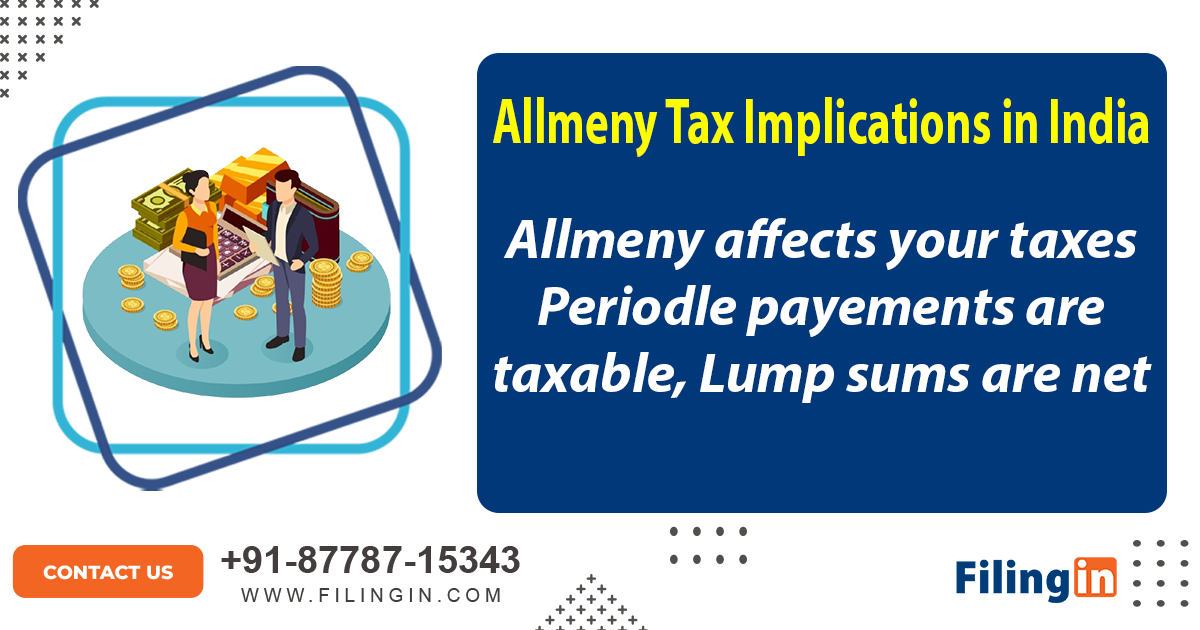In India, alimony tax implications vary based on the payment type. Periodic payments are taxable for the recipient and deductible for the payer. Lump-sum payments, however, are not taxed for the recipient, but the payer cannot claim deductions. Asset transfers are typically tax-neutral, but capital gains tax may apply later. Both parties should maintain proper records and seek expert advice to avoid tax issues.

Alimony Tax Implications: Financial Truths of Divorce Settlements in India
Divorce is often accompanied by emotional and financial turmoil. Among its most critical aspects is alimony, or spousal support, which can significantly impact both parties’ post-divorce financial planning. The alimony tax implications in India play a vital role in determining financial stability after separation. By understanding how alimony payments are taxed, individuals can better prepare for life after divorce.
This article provides an in-depth exploration of alimony tax implications, focusing on lump-sum payments, periodic alimony, asset transfers, and the associated tax responsibilities for ex-spouses.
What are Alimony and Its Objectives?
Alimony, also called spousal maintenance, refers to the financial assistance one spouse provides to the other after divorce. Its objectives include:
- Ensuring financial stability for the financially weaker spouse.
- Compensating for career sacrifices made during marriage.
- Sustaining the standard of living enjoyed during the marriage.
Agreements differ in structure, and each form of payment carries unique Alimony tax implications.
Types of Alimony and Their Tax Implications
1. Lump-Sum Alimony
Lump-sum alimony is a one-time settlement paid during divorce. Under Indian tax laws:
- It is treated as a capital receipt and is non-taxable for the recipient.
- It provides a tax-efficient option for both parties, as no recurring tax liabilities arise.
2. Periodic Alimony
Periodic alimony refers to payments made at regular intervals, such as monthly or annually.
- These payments are taxable under “Income from Other Sources” for the recipient.
- The ex-wife must include the alimony payments in her annual income and pay taxes based on her tax slab.
3. Asset Transfers as Alimony
Some divorce settlements involve transferring assets such as real estate or investments:
- Real Estate: Not taxed during the transfer but subject to capital gains tax if sold later.
- Movable Assets (jewelry, shares): Gains from their sale are taxable.
- Provident Fund or Pension Transfers: Generally tax-free upon transfer but taxable during withdrawals.
These distinctions highlight why understanding alimony tax implications is crucial for structuring financial settlements.
Legal Framework of Alimony Tax Implications in India
Indian courts consider multiple factors when determining alimony:
- Marriage Duration: Longer marriages typically result in higher or longer-lasting alimony.
- Financial Circumstances: Both parties’ incomes, assets, and liabilities are reviewed.
- Standard of Living: Courts aim to sustain the recipient’s marital lifestyle.
Judicial discretion is a critical component, making alimony rulings highly case-specific.
Tax Liabilities for the Ex-Wife
The recipient spouse (usually the ex-wife) bears tax responsibilities based on the form of alimony received:
- Lump-Sum Payments: Not taxable under Indian tax laws.
- Periodic Payments: Treated as income and taxable based on the recipient’s income slab.
- Income from Transferred Assets: Rental income, dividends, or profits from asset sales are taxable.
For example, if a property worth ₹1 crore is transferred as part of the alimony settlement, the ex-wife pays no tax at the time of transfer. However, any rental income or capital gains from a future sale will be taxable.
Tax Deductions for the Husband
Unfortunately for the paying spouse, Indian tax laws do not allow deductions for:
- Periodic alimony payments.
- Asset transfers, such as property or investments.
This lack of tax relief underscores the importance of structuring settlements in a mutually beneficial way while considering the alimony tax implications.
Practical Example of Alimony Tax Implications
Suppose a husband agrees to pay ₹75,000 monthly as periodic alimony and transfers a property to his ex-wife. Here’s how taxation applies:
- The monthly payments are taxable for the ex-wife as “Income from Other Sources.”
- The property transfer is tax-free initially, but any income or capital gains arising from the property will be taxed.
How to Optimize Alimony Tax Planning
For the Ex-Wife (Recipient):
- Opt for Lump-Sum Alimony: To avoid annual tax liabilities.
- Invest Strategically: Use tax-saving instruments to offset liabilities.
For the Husband (Payer):
- Negotiate Asset-Based Settlements: Reduces long-term financial outflows.
- Consult Financial Experts: For tax-efficient alimony agreements.
Both parties should consult legal and financial advisors to structure alimony settlements in a tax-efficient manner.
Alimony settlements significantly affect the financial futures of both parties. Understanding the alimony tax implications helps in structuring settlements that minimize tax burdens and promote financial stability. Whether it’s negotiating lump-sum payments, periodic alimony, or asset transfers, careful planning ensures a smoother transition to post-divorce life.
Frequently Asked Questions
No, lump-sum alimony is non-taxable under Indian tax laws.
No, periodic payments are not eligible for tax deductions for the paying spouse.
Assets are tax-free at the time of transfer but are taxable based on income or gains generated later.
Yes, alimony received as interim or temporary maintenance during divorce proceedings is taxable. These payments are considered “Income from Other Sources” and must be reported in the recipient’s income tax return.
If periodic alimony payments stop or are reduced due to mutual agreement or a court order, the recipient’s taxable income will decrease accordingly. Similarly, any modifications in asset transfers may impact future capital gains or rental income taxation.